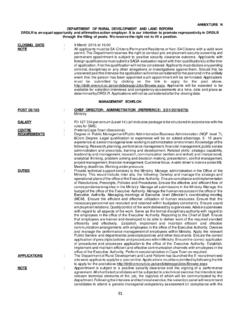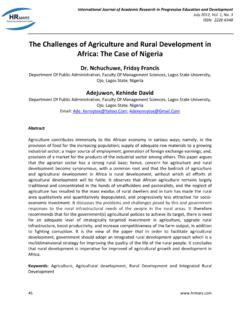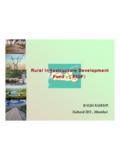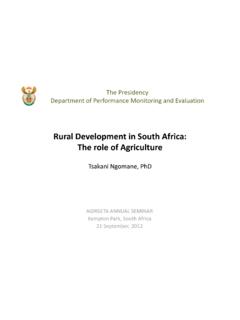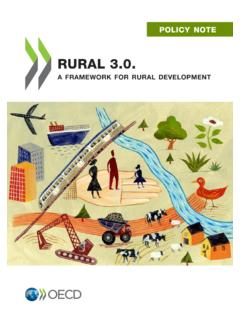Transcription of GENDER AND CLIMATE CHANGE ISSUES IN …
1 TRAINING GUIDE. GENDER AND CLIMATE CHANGE RESEARCH IN. AGRICULTURE AND FOOD SECURITY FOR. rural development . TRAINING GUIDE. GENDER AND CLIMATE CHANGE RESEARCH IN. AGRICULTURE AND FOOD SECURITY FOR. rural development . THE CGIAR RESEARCH PROGRAM ON CLIMATE CHANGE , AGRICULTURE AND FOOD SECURITY (CCAFS). FOOD AND AGRICULTURE ORGANIZATION OF THE UNITED NATIONS (FAO). 2012. The designations employed and the presentation of material in this information product do not imply the expression of any opinion whatsoever on the part of the Food and Agriculture Organization of the United Nations (FAO) concerning the legal or development status of any country, territory, city or area or of its authorities, or concerning the delimitation of its frontiers or boundaries. The mention of speci c companies or products of manufacturers, whether or notthese have been patented, does not imply that these have been endorsed or recommended by FAO in preference to others of a similar nature that are not mentioned.
2 The views expressed in this information product are those of the author(s) and do not necessarily re ect the views of FAO. All rights reserved. FAO encourages the reproduction and dissemination of material in this information product. Non-commercial uses will be authorized free of charge, upon request. Reproduction for resale or other commercial purposes, including educational purposes, may incur fees. Applications for permission to reproduce or disseminate FAO copyright materials, and all queries concerning rights and licences, should be addressed by e-mail to: or to the Chief, Publishing Policy and Support Branch O ce of Knowledge Exchange, Research and Extension FAO. Viale delle Terme di Caracalla 00153 Rome Italy FAO 2011. Cover photo: FAO/Giulio Napolitano ACKNOWLEDGEMENTS. This training guide was prepared by Sibyl Nelson (FAO) with inputs by Moushumi Chaudhury (CCAFS) and edited by Hannah Tranberg (FAO) under the technical supervision of Yianna Lambrou (FAO), Marja-Liisa Tapio-Bistr m (FAO) and Patti Kristjanson (CCAFS).
3 Thanks are given to Wiebke Foerch (CCAFS Village Baseline Team Leader), the CCAFS Village Baseline Team and CCAFS research theme and regional program leaders for their technical inputs and support in hiring the team and overseeing the implementation of the study and to Catherine Hill for her inputs on training approaches. Thanks are also given to Irene Dankelman, Christina Seeberg-Elverfeldt and Katharine Vincent for constructive inputs to the training guide. ii Table of contents Abbreviations and acronyms .. vi PART 1: CONCEPTS AND 1. A. 1. B. How to use the guide .. 1. 1. The purpose and objectives of this guide .. 1. 2. The audience .. 1. 3. Major topics and content of this guide .. 2. 4. What this guide does not cover .. 3. C. Key concepts related to CLIMATE CHANGE .. 3. Module 1: Conceptual framework: GENDER ISSUES and GENDER analysis approaches.
4 6. A. Defining GENDER .. 6. B. Analysing GENDER in the agriculture sector .. 7. C. GENDER analysis of food security .. 10. D. SEAGA approach to GENDER analysis .. 10. Module 2: Concepts: GENDER and CLIMATE CHANGE ISSUES in agriculture and food security ..15. A. What is CLIMATE CHANGE ? .. 15. B. The GENDER dimensions of CLIMATE -smart agriculture in the context of rural livelihoods .. 21. Module 3: Field research tool box ..31. A. Preparing for and carrying out participatory field 31. B. GENDER and CLIMATE CHANGE Research Tools .. 34. Tool 1. Village resources map .. 35. Tool 2. Seasonal calendar .. 37. Tool 3. Daily activity clocks .. 39. Tool 4. Farming systems diagram .. 42. Tool 5. Capacity and vulnerability analysis matrix .. 43. Tool 6. Venn diagram on institutions .. 45. Tool 7. Institutional profiles .. 46. Tool 8. Changing farming practices.
5 47. Tool 9. Seasonal food security calendar .. 49. Tool 10. CLIMATE -related risk management 50. PART 2: GUIDANCE TO USERS .. 52. Module 4: Preparing for field work ..52. Implementation teams .. 52. Process of data collection .. 54. Invitation letters for group participants .. 58. Module 5: Work plan on GENDER and CLIMATE CHANGE in agriculture and food security ..61. Guidelines for implementing the GENDER and CLIMATE CHANGE study .. 61. Day 1 - activity 1: Setting the stage for the study .. 61. Day 1 - activity 2: Public community meeting .. 63. Day 2 - activity 1: CLIMATE analogue session .. 64. Day 2 - activity 2: Weather forecast session .. 69. Day 3 - activity 1: Understanding and catalysing GENDER -sensitive CLIMATE -smart agriculture initiatives . 74. Day 3 - activity 2: Weather forecast session (youths) .. 78. Day 4 - activity 1: Presentation of the summary to community (final community meeting).
6 78. Module 6: Reporting formats ..80. Audit trail - 80. CCAFS FAO debriefing document .. 81. Day 1 - Public community meeting .. 82. Day 2 - topic 1: CLIMATE analogues session for women's group .. 84. iii Day 2 - topic 1: CLIMATE analogues session for men's group .. 86. Day 2 - topic 2: Weather forecast sessions for women's group ..88. Day 2 - topic 2: Weather forecast sessions for men .. 92. Day 2 - topic 2: Weather forecast sessions for female youths .. 96. Day 2 - topic 2: Weather forecast sessions for male youths .. 99. Day 3 - topic 3: Understanding and catalysing GENDER -sensitive, CLIMATE -smart agriculture initiatives . women's group ..102. Day 3 - topic 3: Understanding and catalysing GENDER -sensitive, CLIMATE -smart agriculture initiatives . men's Day 4 - Presentation of the summary in the public meeting ..109. Module 7: Reporting.
7 110. Executive summary of main findings ..110. Topic 1: CLIMATE analogues ..111. Topic 2: Weather forecast session ..112. Topic 3: Understanding and catalysing GENDER -sensitive CLIMATE -smart agriculture initiatives ..114. PART 3: ANNEXES .. 116. Annex 1: Glossary for development , GENDER and CLIMATE CHANGE terms ..116. Annex 2: Additional resources ..123. Annex 3: Bibliography ..126. iv Boxes Box Men's and Women's Multiple Roles at Community Level .. 8. Box Practical and Strategic GENDER Needs .. 10. Box Classic GENDER Analysis Questions .. 11. Box Scientific Evidence of Global CLIMATE CHANGE .. 16. Box CLIMATE CHANGE Impacts on the Four Dimensions of Food Security .. 17. Box Examples of CLIMATE smart activities of small holder farmers .. 19. Box Examples of Coping Strategies Local Women and Men apply .. 23. Box Analogue Approach.
8 23. Box Carbon Projects in Agriculture .. 24. Box CASE STUDY on The Western Kenya Sustainable Agriculture Land Management Project .. 25. Box Mitigation Activities of Smallholder Farmers some insights from existing projects .. 26. Box Carbon Markets .. 27. Box Ten GENDER and CLIMATE CHANGE Research Tools .. 34. Box Suggested Sample Invitation Letter .. 58. Box Suggested script for introducing CCAFS .. 63. Box Suggested Script for Obtaining Informed Consent .. 64. Figures Figure 1: The greenhouse effect mechanism .. 15. Figure 2: Food System .. 20. Figure 3: Example of a Village Resource Map of Khajret Uperli Guanguri, India .. 37. Figure 4: Example of a Seasonal Calendar - women from Xuan Truong, Vietnam .. 38. Figure 5: Example of Seasonal Daily activities of women and men in Dzinavene, Chivi District, Zimbabwe .. 41. Figure 6: Example of a Household Agro-ecosystems and rural Resource Management, Bangladesh.
9 43. Figure 7: Example of Women's and Men's Perceptions of Institutions in El Zapote, Honduras .. 46. Tables Table : Guide's parts and modules .. 2. Table : Key Concepts related to CLIMATE CHANGE .. 4. Table : GENDER Gaps in Agriculture .. 9. Table : GENDER ISSUES related to the Four Components of Food Security .. 11. Table : CVA Matrix .. 44. Table : Example of Institutional Profiles of Jeded Village, Somalia .. 47. Table : Example of Categories for Changing Farming 49. Table : Summary of the activities and the number of focus groups required .. 55. Table : Summary of the village programme .. 61. Table : Help for Discussing the Daily Weather Forecasts .. 71. Table : Questions for Discussing the Seasonal Forecasts .. 73. v Abbreviations and acronyms CBA Community based adaptation CCAFS CGIAR Research Program on CLIMATE CHANGE , Agriculture and Food Security CDM Clean development Mechanism CGIAR Consultative Group on International Agricultural Research COP Conference of Parties CVA Capacity and Vulnerability Analysis FAO Food and Agriculture Organization of the United Nations GHG Green house gas IPCC Intergovernmental Panel on CLIMATE CHANGE NGO Non-Governmental Organization PAR Participatory Action Research PNA Participant Needs Assessment PRA Participatory rural Appraisal SEAGA Socio-economic and GENDER Analysis UNFCCC United Nations Framework Convention on CLIMATE CHANGE UNDP United Nations development Programme WTA Willingness to accept payment WTP Willingness to pay vi Part 1: Concepts and tools A.
10 Introduction It is widely accepted that agricultural development will be severely curtailed without addressing the risks and capitalizing on the opportunities posed by CLIMATE CHANGE (FAO, 2010b). The agriculture sector must adapt to the impacts of CLIMATE CHANGE in order to provide food security to the world's growing population. At the same time agriculture must mitigate its contributions to CLIMATE CHANGE ( percent of global greenhouse gas emissions) in order to slow the progression of this global challenge (FAO, 2009). Concurrently, it is internationally recognized that addressing GENDER ISSUES in agriculture reduces hunger and poverty. In fact, it is estimated that more than 100 million people could be lifted out of poverty if women had the same access to and control of resources as men (FAO, 2011a). Although they are important food producers and providers, women presently have limited access to and control of resources.











